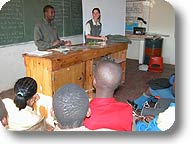
 |
Addo Elephant National Park |
Environmental Education |
|
|
|
 |
Environmental education involves a range of processes, which support environmental learning, in all learning areas. Environmental learning involves developing an understanding of the environment and its issues, and values and skills that will help learners to contribute to the protection and improvement of environments. Part of this process is teaching ecological literacy, creating sustainable human communities designed in such a manner that their ways of life do not interfere with nature's inherit ability to sustain life. For communities to grasp this ecological literacy, a great deal of awareness is necessary. There are many forms of awareness that can be presented to communities in order to achieve this. The forms of awareness are tailored to the age group targeted, the youth being the most effective target group of a community as they are impressionable and opinions are open to new concepts. Slide shows and role plays are presented at local schools and various school groups led on guided tours in the Park. To present the Park as a learning centre for schools, learners on educational trips are given free entrance to the Park. Future plans involve the establishment of an environmental education centre and environmental education programme as part of the World Bank project. Through this project, a bus has been acquired, giving a boost to EE initiatives. This vehicle will be used to transport learners from local community schools to the Park, where they can use the Park as a learning centre.
|
School Visits |
|
SANParks encourages the use of national parks as learning centres where young South Africans can learn about their natural and cultural heritage. Special discounts are available for educational visits.
|
|
Student Volunteers |
|
| Opportunities exist for interested young people to gain first-hand experience of conservation in a National Park. A four-week or eight-week experience allows the student to take part in the day-to-day conservation work of a Big Five national park. No prior experience is necessary, only a keen interest in nature and a willingness to be involved in all aspects of this work. | |
Development Programmes |
|
Mayibuye Ndlovu Development ProgrammeAn effective liaison structure between the Park and the local communities is a vital aspect of People & Conservation work. The current structure of the Mayibuye Ndlovu Development Programme ("Mayibuye Ndlovu" means "let the elephant return" in Xhosa) had much humbler beginnings in the early 90s when a Community Forum was formed as a result of conflicts between the Park and Nomathamsanqa community. This later developed into the Mayibuye Ndlovu Arts and Craft Project, with crafters selling their craft at the park entrance gate. |
|
Research and Monitoring |
|
| The Addo elephants are probably the world's most comprehensively recorded elephant population. Elephant research began in earnest in 1976 when Dr. Anthony Hall-Martin researched the Addo elephant population. In this study he built up a complete photographic identification file for the population (a total of 96 elephants in May 1978), documented the sex, estimated age, and developmental status of all individuals, and kept records of births and deaths within the population. Additionally, notes were kept on observed association patterns and social behaviour.>>>
Contact details/Enquiries: Dr Ayanda Sigwela |